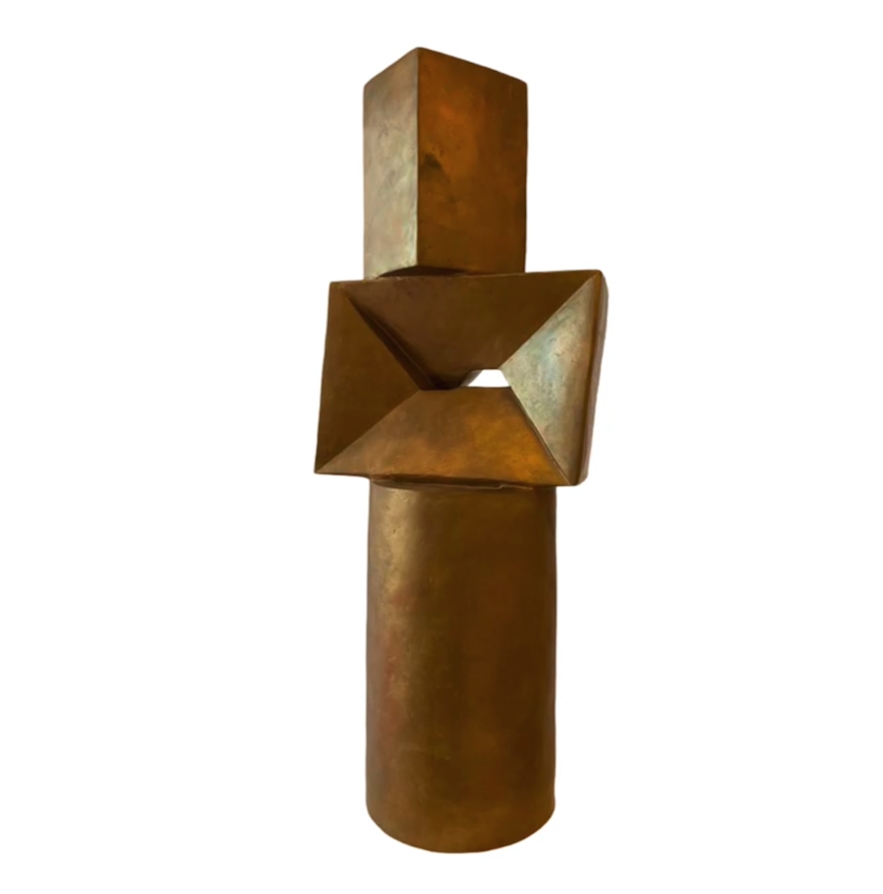
Title: MIKRI PARAMORFOSII
Material: BRONZE 10KK
Size: 100 CM X 38 CM X 26 CM,
ASK FOR PRICE
1/5 1976
LOUKOPOULOS KLEARCHOS, 1906-1995
Klearchos Loukopoulos was born in Thermo, Aetolia in 1906. He first became interested in art at the age of 16, when he worked with the painter Konstantinos Maleas, who was making drawings and paintings for the excavations at Thermo. In 1924 he went to the Athens Law School while also taking up drama at the National Theatre and music at the National Conservatory. Soon, however, Loukopoulos had to leave Greece in order to seek medical treatment. After his recovery, he travelled around Europe to study art in various European Museums. He became close friends with the painters Tsarouchis and Diamantopoulos and in 1938-1939 studied painting with Vyzantios. At the same time he set up his first sculpture studio. After the war, from 1945 until 1950, he studied sculpture at the atelier of the sculptor Thanasis Apartis, all the while travelling extensively in Europa and the USA in order to keep abreast of artistic developments.
Inspired by pre-classical ancient Greek sculpture and modernist trends alike, Loukopoulos became a pioneer of abstract sculpture in Greece. His early artwork consisted of figurative, anthropomorphic sculptures rendered in limestone or marble. Towards the end of the 1950s he started to work almost exclusively in metal and concurrently his sculptures became more abstract. In the 60s he all but abandoned figuration in favour of compact, curvilinear geometrical compositions that became more dense and solid in time. For Loukopoulos line, surface and volume were the basic elements of the art of sculpture. These geometric ‘quantities’ provided the sculptor with a basic plastic alphabet that could be endlessly varied to express the personal idiom of the artist. His main stimuli were the exploration, with purely sculptural means, of the concept of space and the phenomenon of ‘being and becoming’. According to Matoula Scaltsa, Loukopoulos was, in fact, a ‘sculptor builder’, his compact masses built up like structural elements. The orientations and development of planes in his sculptures were aimed at the widest possible field of visibility, which firmly placed them in space. In the words of the art critic Alexander Xydis: “The sculpture of Loukopoulos is monumental even in small works.(….) Closed and firm from every side, they unequivocally occupy the space they create. Visible from all sides, always balanced, they acquire life and movement by the profound indentations, which condense the shade, leaving the light to run freely over the surfaces and edges of the planes’
In the 70s and 80s Loukopoulos joined masculine components, characterized by compact volumes, with feminine counterparts, rendered in curvilinear planes. Never complacent, he also experimented in the 1980s, his last creative period, with new materials such as plaster, zinc, polystyrene and wax.
Loukopoulos was not only a sculptor, but as such also published many articles on modern art in newspapers and art magazines. His work was honored with several awards and distinctions, such as the Award from the International Union of Art Critics, awarded by the Greek branch of ALCA in 1963 and the National Art Prize in 1972, which he refused in protest against the Greek junta in power at that time. Deeply aware of the importance of art, Loukopoulos took an active part in the cultural life of his country. In 1976 he joined the ‘Group for Communication and Education in Art’, serving as its president for four years.
The sculptures of Loukopoulos are included in numerous public and private collections in Greece, France, the United States, the UK, Japan and Cyprus. He showed his work in many solo and group exhibitions, both in Greece and abroad. In 1956 and 1966, for instance, he represented Greece in the Venice Bienalle. Between 1962 and 1966 he collaborated with architect Aris Konstantinidis and created a series of monumental, constructivist compositions for the Greek National Tourist Board (EOT). In fact, his work can be found in public places throughout Greece, a noteworthy example being the Stele (1976) at the Ethniki Amina Metro station in Athens.
In 1997, two years after his death, a retrospective exhibition of the artwork of this major Greek sculptor took place at the Vafopoulio Cultural Centre in Thessaloniki.

